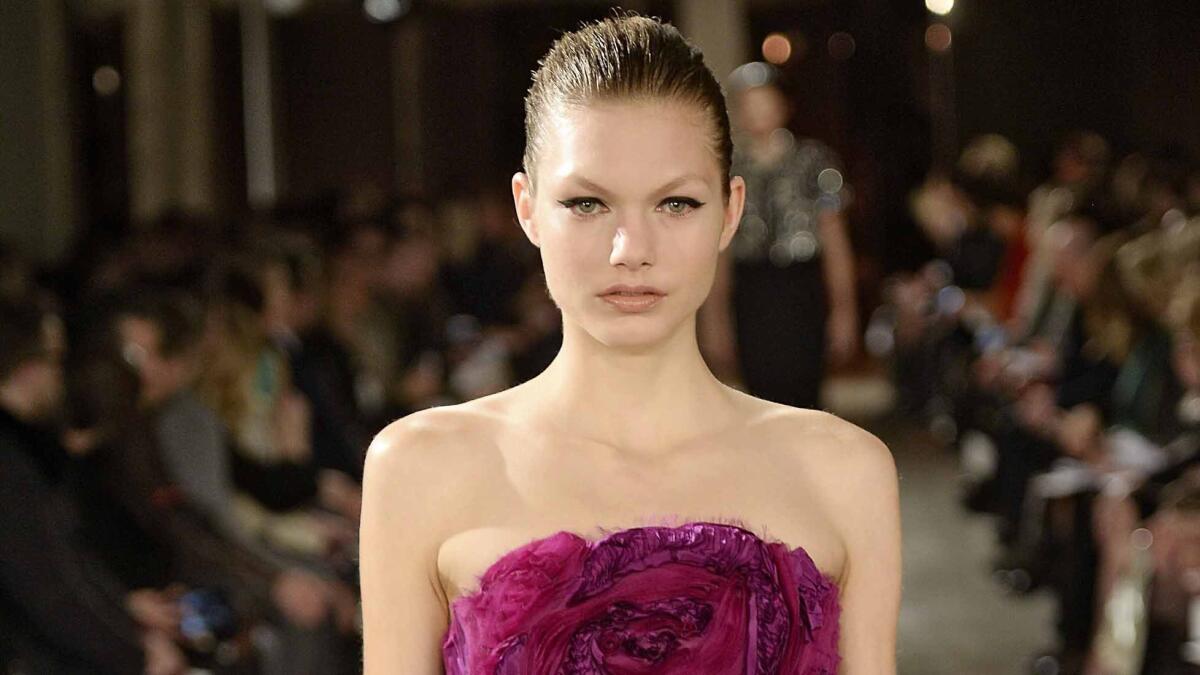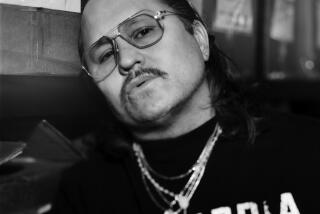New York Fashion Week: The visionaries of womenswear

Reporting From New York — The biggest news at the women’s fall 2015 shows at New York Fashion Week, which ended Thursday, was a changing of the guard at Oscar de la Renta. British-born designer Peter Copping was charged with continuing the legacy of the late designer, who died in October at age 82 and who was one of American fashion’s most beloved figures.
Copping’s debut was Taylor Swift-approved — the pop singer, who has worn Oscar de la Renta many times, sat front row. The clothes stayed true to De la Renta’s aristocratic outlook. But Copping also added a French touch, carried over from his time at the helm of Nina Ricci. Skirts were shorter and cocktail dresses more flirtatious, including several seductively sheer styles with lace and corsetry.
It was one of the few dressed-up collections to come down the New York runways until Marc Jacobs closed out the week with an ode to fashion’s feared fairy godmother of propriety and perfection, legendary Vogue editor Diana Vreeland (who helped shape De la Renta’s career, it should be mentioned) and other women of her ilk who would never dream of leaving the house without looking impeccable.
A requiem for making an effort, Jacobs’ bid for fashion and formality was remarkable in a season when so many collections featured casual layers, low-key luxe and comfy clodhopper shoes.
At Michael Kors, for instance, the theme was restrained elegance — with a wink. Want to wear your pajamas out? Kors covered ‘em in crystals. Too lazy to put on a coat? How about an ombre fox fur “bathrobe” instead?
Kors was tapping into today’s anything-goes, comfort-is-king, casual fashion mood. And in the process, he ticked off many of the week’s trends: tweedy, menswear-inspired tailoring with wider-leg trousers and calf-length skirts; feminine, frilly blouses; cozy sweater dressing; and effortless evening wear. He even had the accessories down, namely the fur stole (preferably belted over a coat or jacket) and that no-nonsense throwback to the 1990s, the lace-up, chunky-soled shoe. Rodarte and Joseph Altuzarra also showed compelling collections combining masculine and feminine, foppish and foxy. While Vera Wang channeled an austere, nearly all-black glamour, similar to the Carolyn Bessette Kennedy-inspired simple chic that permeated Wes Gordon’s fall outing.
Other designers riffed on streetwear, military uniforms and utility clothes.
At Marc by Marc Jacobs (the designer’s diffusion line), models posing as rebel youth walked to the beat of Public Enemy’s 1989 protest anthem “Fight the Power” wearing studded berets on their heads, studded combat boots on their feet and social action on their sleeves with words like “solidarity” and “choice” displayed on graphic tees and dresses. There were also army green floral printed jackets, long pleather skirts and destroyed moto jeans. The message — perhaps aimed at under-consuming millennials — is that it is possible to have style and substance.
The Public School collection broke barriers by blurring the lines between masculine and feminine, Eastern and Western dress, streetwear and tailoring. The result was a layered, urban nomad look — a red brushstroke-patterned sweater over a long, flannel check tunic over track pants, for example, and a black leather jumper dress with long pleated skirt, under a shrunken jacket that was half-blazer, half-bomber.
Alexander Wang’s vision was fiercely androgynous and heavy metal glam, from sweaters studded with silver balls, to swishy skirts dripping silver chains. Meanwhile, Phillip Lim brought a deconstructed grunge to streetwear, turning the ubiquitous plaid flannel shirt into an asymmetrical skirt, drapey trench coat and flight suit, shown on the runway with paratrooper pants, spidery knits, and silk charmeuse slip dresses worked with patches of destroyed lace.
Then there were the few true visionaries, those mad scientists of the runway who aren’t afraid to experiment. Jacobs was surely one of them, and so was Narciso Rodriguez.
From Bessette Kennedy’s famous white satin wedding slip dress, to pop singer Lorde’s Golden Globes red carpet pantsuit and bra top, Rodriguez has been refining his brand of restrained elegance for years, proving that sophisticated minimalism and sex appeal are not mutually exclusive. He worked a long, lean, liquidy silhouette, with sleeveless shawl collar coats and skirts and trousers with exaggerated high waists. Underneath, sheer bodysuits over bra tops teased the idea of nudity and seduction. The result was a towering female presence. His finale looks were also envelope-pushing, including a white silk, bias cut top that spiraled into a formal-wear-type tail and was worn over black pants making for a new, creative black tie.
At Thom Browne, an operating theater for a runway set put the focus on the designer’s surgical-like detail work. White lab-coated doctors worried over patients on stretchers. A dramatic snowfall occurred, then a “death” and an ascension. And that was all before the heart-stoppingly beautiful parade of all-black-mourning-attire-as-fashion even began. The clothes were radical in that they were so rich with couture-quality, 3-D effects — raffia seams, mink “cable knit” intarsia, rubber yarn, feather and bugle bead trim and corded embroidery.
The spirit of experimentation was alive at Proenza Schouler too. Designers Lazaro Hernandez and Jack McCollough took cues from Abstract Expressionist artists, including painter Helen Frankenthaler. “Nothing too controlled,” Hernandez said of the collection. “Just putting paint to canvas.”
Or in their case, scissors to tweed jackets and skirts cut into dynamic-looking strips; slashes to sweater dresses that spiraled around the body, revealing black oval mesh stockings worn underneath; needle punches, flock prints and doodle-like embroidery to wool trousers, pullovers and plunge-front dresses.
For evening, they used tinsel-like copper embroidery, fur trim, grommets and disks with childlike abandon, creating tribal-looking body-assemblages-as-dresses.
To see a fashion collection that was more about the creative process than the end result, and so well done too, may have been the most thrilling thing of all.







